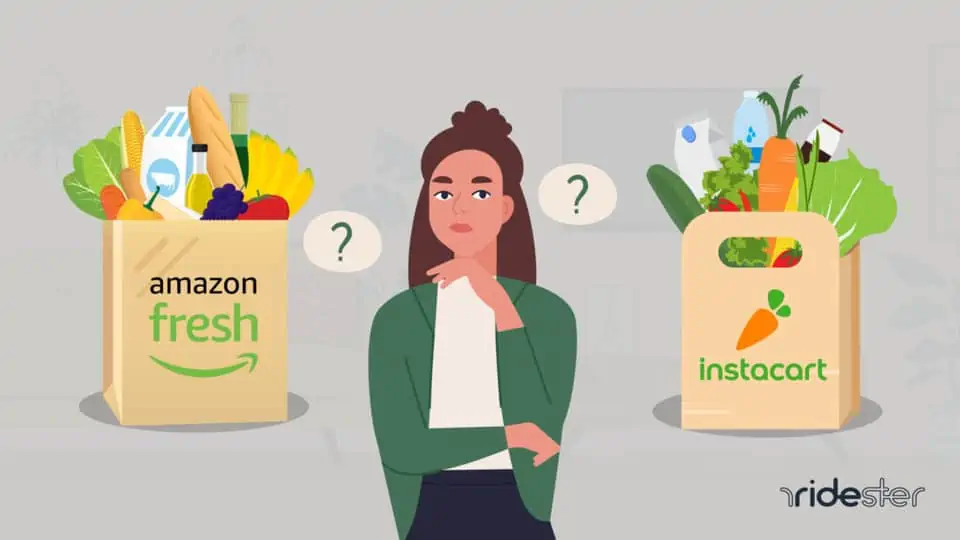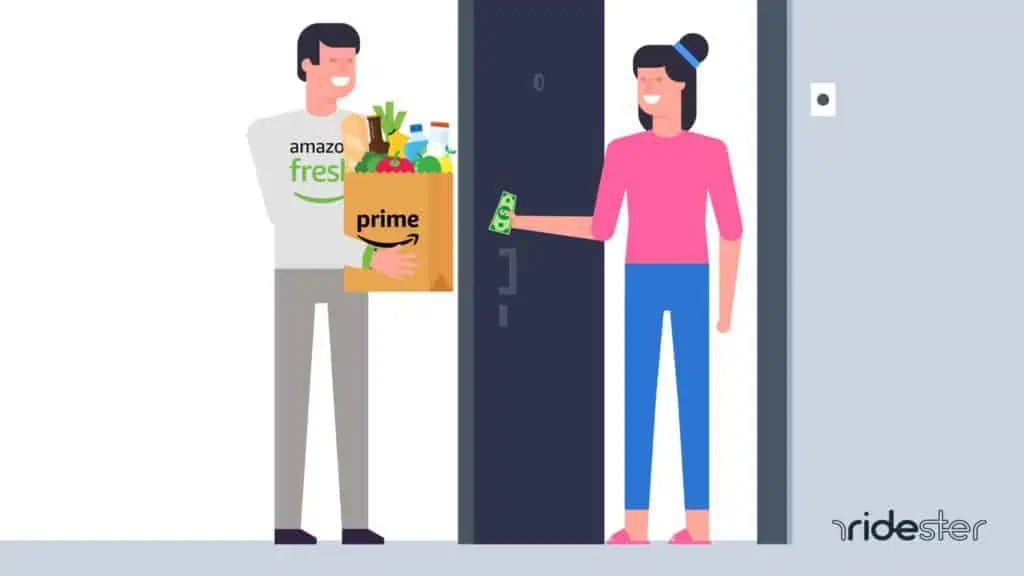Key Takeaways
- Instacart offers grocery delivery from various local stores, enhancing community connection.
- Amazon Fresh operates as a virtual and physical grocery store with efficient delivery.
- Instacart’s flexible scheduling benefits both customers and drivers for pre-planned orders.
- Amazon Fresh requires Amazon Prime, offering streamlined service but less local variety.
Instacart vs Amazon Fresh: An Overview
Before we start comparing them, we need to identify exactly what these products are. They both function in unique ways, though they are also both quite effective.
| Feature | Instacart | Amazon Fresh |
|---|---|---|
| Service Type | Grocery delivery from various local stores | Virtual and physical grocery store with delivery |
| Scheduling | Flexible scheduling for customers and drivers | Requires Amazon Prime membership |
| Local Variety | Offers local grocery variety and community connection | Streamlined service with less local variety |
| Availability | Greater access to locally-grown produce and craft goods | More stable inventory but lacks local specificities |
| Stores | Access to over 70,000 stores across 5,500 cities | Operates its own stores, limiting external store variety |
| Deals | Deals through individual stores and website promotions | Consistent standard promotions within its platform |
| Service | Potential for high personalization but variability in service quality | More consistent, impersonal service experience |
| Prices | Dependent on individual retailer prices | Centralized pricing through negotiations with manufacturers |
| Delivery Fees | Various fees, tipping encouraged | More straightforward fee structure, Prime membership required |
| Memberships | Instacart Express reduces or eliminates fees without requiring other memberships | Requires Amazon Prime, adding cost if not already a member |
| Pros | Individualization, access to local stores | Efficiency, potentially wider single-order item availability |
| Cons | Potential inefficiency, limited by local store partnerships | Lacks local distinctiveness, prioritizes standardization |
| Best For | Customers valuing local variety and personal shopping experience | Customers prioritizing efficiency and streamlined service |
What Is Instacart?
Instacart is a North American grocery delivery and pick-up service that connects customers with personal shoppers who buy and deliver groceries from participating stores.
Founded in San Francisco by former Amazon employee Apoorva Mehta, the service operates through a proprietary app, allowing customers to select groceries from local stores.
Shoppers use a company-issued credit card to make purchases and then deliver them via car or bicycle, or arrange for customer pickup.
Customers can communicate with shoppers during the process and are charged for their order plus delivery fees and tips upon completion.
Suggested Read: How does Instacart work?
What Is Amazon Fresh?
Amazon Fresh is a grocery delivery and pick-up service integrated into Amazon’s platform, offering a seamless way to shop for groceries alongside other Amazon products.
Launched in 2017, Amazon Fresh has evolved from an initial delivery/pick-up model to include both a robust online service and physical stores known as Amazon Fresh Marketplaces.
These stores feature innovative checkout processes that eliminate the need for traditional checkout lines by allowing customers to scan a QR code, pick up items, and leave.
Amazon Fresh simplifies grocery shopping by leveraging Amazon’s efficient delivery system to offer perishables and proprietary items like meal kits and baked goods, making it a standalone virtual grocery store distinct from other services that rely on existing grocery store infrastructures.
Instacart vs Amazon Fresh: Who Does It Best?
Now that we’ve explored how each service works, we can figure out which one is better for the customer at each level.

Availability
Instacart is a slightly better option for availability, though there is some contention here.
Since Instacart takes advantage of the existing stores in a given area to provide its available supply, you’ll have access to a variety of items that may connect to your specific community.
As a result, you’ll have an easier time accessing locally-grown produce and unique craft goods through them.
Amazon Fresh, on the other hand, has a much more stable inventory.
Because it is centralized, you won’t have the specificities and local quirks that you have access to through Instacart.
Instead, you have access to the whole catalog that Fresh has available in your area at the same time.
With Instacart, if you want to purchase items from more than one store, you need to do a separate order for each store.
So even though its overall variety is likely more substantial than Amazon Fresh’s, you almost certainly have access to a wider swath of items within a single order from Amazon Fresh.
Stores
Amazon Fresh only uses one kind of store – itself – even though it partners with several other brands of food manufacturers.
So when it comes to stores, it has little competition with Instacart, which offers food from over 70,000 stores across 5,500 cities.
As discussed above, an advantage in a breadth of stores doesn’t necessarily mean an advantage in quality or availability.
Deals
On the question of deals, both platforms must be considered relatively equal.
There isn’t a way to find hard data on which one offers better or more frequent deals.
But even further, the two models are so thoroughly different that it would be very challenging to find points on which to compare them.
Instacart has two types of deals: deals through an individual store and promotions through their website.
The latter kind of deal typically exists around free or reduced-cost delivery, which are almost exclusively limited to non-members since members enjoy free delivery on most orders.
But that begs the question, does Instacart mark up food prices?
As for in-store deals, individual retailers set prices and promotions through Instacart separately from price-setting within the store.
Certain deals and promotions may be available within the store that is not available through the Instacart platform.
Amazon Fresh has primarily one type of deal – the standard promotions you would expect to find within a local store.
But it has those deals reliably and consistently.
Service
There isn’t a clear winner for customer service between these two programs.
Amazon Fresh tends to provide a more consistent experience, while Instacart has more opportunities for both positive and negative service interactions due to its greater individualization.
With Amazon Fresh, there is no personal interaction required.
You are simply purchasing a series of items from a distributor.
This has all the benefits and drawbacks of impersonality – it’s a generally more efficient way of going about things, but you certainly won’t undergo a memorably relational experience with someone.
With Instacart, on the other hand, you do need to navigate the inefficiency of working with a human person who is going through the grocery store on your behalf.
This can lead to missed items and interpersonal confusion more often than in the much more procedural version that Fresh offers.
But this also allows for moments of exceptional service that you couldn’t get otherwise.
At the end of the day, most people likely prefer reliability to only a possibility of excellence when it comes to grocery delivery, so Fresh is probably a better option here.
Prices
There is no solid way to compare prices between the two outlets since there is so much variation from place to place.
Instacart’s prices depend entirely on the prices of the individual retailer, while Amazon Fresh’s prices are determined more centrally through direct negotiation with manufacturers.
Delivery Fees
Amazon Fresh beats out Instacart when it comes to delivery fees with little question.
Both services have a similar pricing structure on the surface – orders over $35 ($50 in some locales for Amazon Fresh) have no delivery fee.
That is only true for members of Instacart Express in Instacart’s case, but as we’ll discuss below, shopping at Amazon Fresh is limited to Prime members, so Instacarts limited free delivery should not count against them here.
That said, service fees and tips do count against the service.
Several fees accompany any given Instacart order, but you will always have to pay a service fee in addition to your existing delivery fee.
And it is always polite to leave a tip when you use Instacart, but some may find this social expectation a significant cost burden.
That said, for others, the opportunity to tip your shopper through Instacart may be an advantage – it is a beautiful thing to be able to thank the people who help you out in a very concrete way.
Suggested Reads:
Memberships
When considering memberships, Instacart is firmly ahead of Amazon Fresh.
This is using their membership subscription which they call Instacart Express.
There’s one primary reason behind this: Fresh requires you to have an Amazon Prime membership before you can use it, while Instacart can be used without a membership and just reduces (or eliminates) many of the fees mentioned above.
Further, if you want to use Amazon Fresh at all, you need to pay for the whole of Amazon Prime.
That means that you’re paying for all the other benefits Prime gives if you just want to order groceries through Fresh.
Instacart vs Amazon Fresh: Differences
The primary difference between the two services lies in their different focuses.
Instacart focuses on using personal shoppers to navigate the existing world of grocery stores, while Amazon Fresh operates as an independent store.
Instacart vs Amazon Fresh: Pros and Cons

Pros of Instacart vs Amazon Fresh
As we’ve discussed, Instacart has clear superiority when it comes to stores and memberships.
On the other hand, Amazon Fresh is the frontrunner when it comes to pricing and delivery fees.
Beyond that, there is so much variance between the two that it’s hard to talk about which one is better.
But there are some clear themes of advantages that run throughout these different categories.
Instacart has the benefit of significant individualization.
Because it works through existing grocery infrastructure rather than creating its own, it has a wide variety of different availabilities and local grocery store access.
Amazon Fresh, on the other hand, works on a much more standardized level.
That leads to greater efficiency overall and in some cases wider availability.
Instacart vs Amazon Fresh: Cons
The cons of each service are in many ways the inverse of the pros.
The individuality of Instacart leads it to be limited in some ways and potentially inefficient in others, while the standardization of Fresh prioritizes efficiency to the exclusion of any kind of local distinctiveness.
Instacart vs Amazon Fresh: Winner?
At the end of the day, there isn’t a clear winner between Instacart and Amazon Fresh – it fully depends on what you want your grocery ordering process to look like.
If you want something that maximizes a smooth, streamlined process with maximum efficiency and minimal hiccups, Amazon Fresh is probably the best bet for you.
But if you prioritize the individual quirks of your particular community, for better or worse, Instacart is a superior option.
Because Instacart allows you to connect with your local stores and retailers, there is much more room for you to experience the culinary beauty of your specific area within it.
Is Instacart Worth It?
Instacart is worth it, especially if you want to plumb the depths of the different grocery options your area offers without having to undertake the hassle of continuously visiting new grocery stores.
Is Amazon Fresh Worth It?
The answer to this question fully depends on whether or not you are already an Amazon Prime member.
If you do, then it is probably worth it to go with Fresh over Instacart.
If not, it likely is not worth it to use instead of the other options on the market.
Wrapping Up
At the end of the day, a membership with Instacart is primarily useful if you want to take advantage of your local offerings, while a Fresh membership is best if you desire efficiency above all else.
Still confused about which to pick? Check out our Amazon Fresh vs Whole Foods guide.







